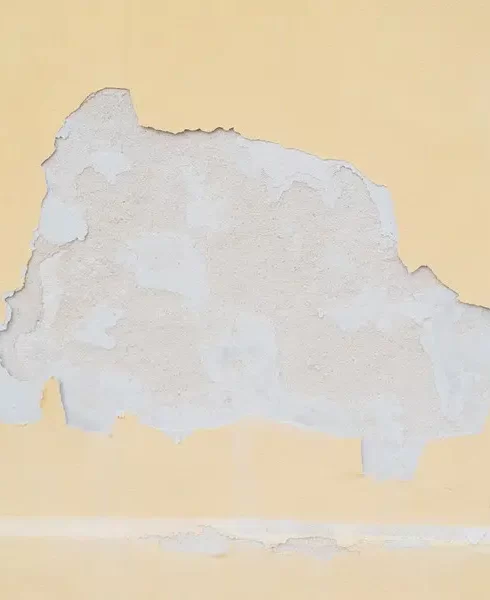Contact Sussex Damp Experts Now to Speak With an Expert.

Rising damp is a prevalent form of moisture that affects building walls. Through capillary action, groundwater rises through microscopic channels in the bricks like a series of straws, carrying with it salts that move up the wall as well. Porous construction elements such as plasterwork and timber found in floorboards, joists and skirtings are also affected by this phenomenon. These materials readily absorb groundwater which can lead to wet rot in wood. The damage caused by rising damp is usually detected on internal walls where plaster and paint erode over time, wallpaper loosens and visible stains emerge on the wall resembling tide marks at points where groundwater has reached.

Rising damp is often confused with condensation damp, leading to misdiagnosis. The Code of practice for the Investigation and Control of Dampness in Buildings advises comparing moisture levels in masonry or mortar samples from within the depth of a wall and near its inner surface to differentiate between the two types of damp. Rising damp can also be correctly diagnosed but inadequately treated due to failed injection of chemical DPC cream. This results in disappointed customers and damages the industry’s reputation.
Sussex Damp Treatments offers expert services provided by professionals with extensive experience, guaranteeing all work and materials used for peace of mind when addressing the property’s damp problems. Contact them today at **XX** for advice on how best to deal with your property’s situation through no-obligation site surveys conducted by experts.
The presence of tidal lines above the skirting on your wall, accompanied by powdery white salt deposits, are clear indications of increased humidity levels.
This rise in moisture has the potential to cause plaster to bubble and wallpaper to peel. It is essential that you take immediate action upon noticing these signs as they can lead to more severe damage if left untreated.

Contact Sussex Damp Experts Now to Speak With an Expert.
Rising damp can affect both the internal and external walls of a property. It is important to be vigilant for signs of rising damp, such as a yellow or brown tidal line left on the wall, blown plaster directly above skirting boards, rotten or cracked floors near walls, white and fluffy deposits in/on plaster that appear salted, and discolouration caused by mould, fungus and mildew. These indicators are crucial to identify early on as they can lead to significant damage if left untreated. Therefore it is essential to take immediate action if any of these symptoms are present in your property.
Distinguishing the smell of rising damp from other types of moisture can be a challenging task, as it emits a musty and moist odour. This distinct scent is often difficult to identify, making it crucial to seek professional assistance in diagnosing and treating the issue.
For decades, physical damp-proof courses (DPCs) have been used in building design to prevent moisture from damaging walls. However, these barriers are not always effective at stopping rising damp. Over time, physical DPCs can become damaged or improperly installed, especially in older homes. Additionally, renovations and extensions can inadvertently damage the built-in DPC layer by altering ground levels and creating new pathways for moisture to rise through previously unaffected areas of the structure. In such cases where rising damp is present despite a physical DPC being in place or has been compromised due to external factors, a repair DPC must be erected as an additional protective measure against further moisture infiltration.
Rising damp in walls, also known as ascending capillary moisture, is caused by the ascent of moisture through elongated and tiny tubes called capillaries.
These tubes vary in thickness and can generate voids within the masonry. Capillary force arises from surface tension, which becomes more potent as the diameter of the capillary decreases. This force causes moisture to rise faster when capillaries are smaller. The impact of this phenomenon is exploited both in medicine and nature where it serves as a water-conducting system for plants.
However, in brickwork with thin piliform tubes, such action may have detrimental consequences resulting in rising damp against gravity – referred to as capillary action. Therefore, it is essential to understand how these forces work so that appropriate measures can be taken to prevent rising damp issues effectively.

To prevent water from seeping into the structure, a damp proof course (DPC) is typically installed at the base of the walls. These courses are constructed using non-absorbent materials such as slate, bitumen or plastic depending on when the property was built. However, physical DPCs may deteriorate over time or be absent in older homes. In such cases, water can easily travel up through walls without any obstruction.
Even if a DPC exists, it could still be ineffective due to various reasons like debris accumulation in wall cavities or beneath floors; overlapping renders or plasters inside/outside of the DPC; raised ground levels outside of it; inadequate insulation material within cavity walls; solid flooring and abutting garden/intersecting masonry structures among others that bridge the DPC’s effectiveness.
The appearance of rising damp on interior walls is often the first indication of a problem. The tell-tale tide marks that appear are indicative of water reaching a certain height, usually up to one metre above the skirting board. However, in rare cases, water can travel beyond this limit. The extent to which water rises depends on various factors such as pore structure and evaporation rate. Masonry with fine pores will allow for greater water absorption than those with fewer pores.
Groundwater typically contains salts which are deposited onto walls during evaporation; these salts can cause paint to bubble and leave behind white deposits or crusty patches depending on their composition. Hygroscopic salts like nitrates and chlorides continue to attract moisture even after initial removal, necessitating proper handling procedures for effective remediation efforts.
Rising damp can be identified through common signs, which are also visible on external walls. The capillary process that moves groundwater up through masonry is responsible for rising damp in external walls. This occurs when a DPC fails or does not exist or when it has been bridged. To detect evidence of rising dampness on walls, look out for tidal markings and disintegrating mortar between the bricks or stones, as well as salt deposits.
Rising damp is a significant issue that must not be ignored as it can lead to structural damage. It is an unpleasant experience to live with, as it can cause harm to your plaster, flooring and decorative finishes, in addition to producing an unpleasant odour. Moreover, rising damp is detrimental to one’s health and can exacerbate respiratory illnesses. The energy consumption of the property may also increase due to heat loss caused by this type of dampness. Therefore, immediate action should be taken if you suspect that your home has rising damp issues.
Rising damp can have a significant impact on the plaster, wallpaper, paints and skirting boards in your home. To address this issue, it is essential to tackle the root cause of the problem and restore any internal wall decor that has been affected. One highly effective and cost-efficient solution for treating rising damp is through the use of an injectable cream. These creams are available as individual cartridges or complete kits.
The cream is manually injected into designated holes within the mortar course before reverting back to its liquid state upon insertion. This allows it to penetrate bricks and absorb all moisture present. As it cures, a robust water-repellent barrier forms along with a new molecule called DPC which prevents further water from climbing up walls.
An alternative approach involves installing a new damp proof membrane as part of a physical damp proof course; however, this method requires significantly more time and effort since each brick must be removed individually along damaged mortar courses before being replaced with fresh barriers.
When constructing a house, builders typically instal a Damp Proof Course (DPC) made of stainless steel or plastic sheeting. Retrofitting this after the fact can be challenging, but it is possible to vibrate stainless steel sheets into walls using saw-cut slots with the help of a tradesman. Alternatively, there are simpler retrofit options available such as injectable water-repellent creams, gels or pastes that work well on any type of wall and are ideal for professional application.
For stone walls, the cement-based mortar that blocks pores must be injected repeatedly by professionals. Osmotic water repellence involves implanted wires and is generally intended for professional use only; it can be passive or active depending on the situation. If you have cavity walls in your home, you will need to instal DPCs on both internal and external walls regardless of which method you choose. In cases where exterior ground levels exceed interior floor levels, dig trenches along exterior walls deep enough so that DPCs align with concrete floors or raised wood floors inside your home.
When properly installed, chemical injections are highly effective in treating rising damp. These formulas have undergone significant evolution over time and now provide long-term protection against the issue.
To effectively treat rising dampness on both internal and external walls, it is necessary to remove any wallpaper and plaster back to the bricks or substrate. Prior to injecting a new Damp Proof Course (DPC), ensure that the old one has not been bridged in any way. Once the injection technique has been followed, make good and redecorate internally by using a moisture-proof membrane, also known as a Damp Proof Membrane (DPM). This will quickly accomplish the task of preventing further moisture from penetrating through the walls. By following these steps with precision, you can effectively eliminate rising dampness in your property’s walls while ensuring they remain aesthetically pleasing.

Once the source of dampness has been resolved, it is crucial to repair any damage caused to the décor. Alternatively, a range of damp-resistant products can be used for replastering the wall. After injecting a new Damp Proof Course (DPC), it is necessary to re-plaster the affected area. If old plasterwork remains, it may contain hygroscopic salts that attract moisture and cause further issues with salt contamination. Therefore, it is essential that you instruct your plasterer to follow precise specifications during re-plastering in order to avoid such problems from occurring again.
If you suspect rising damp in your property, it is crucial to seek a professional diagnosis to validate your concerns. A competent surveyor or preservation firm with experience in rising damp injection therapy should be your first choice. The surveyor will conduct a thorough analysis and recommend a remedy based on their results. When selecting someone to cure the problem, look for certain qualities such as recognised industry credentials like the Certificated Surveyor in Remedial Treatments (CSRT) qualification which includes modules on damp, and the Certificated Surveyor in Structural Waterproofing (CSSW) qualification for those who diagnose and offer design solutions for water entering structures below ground level.
For rented properties, landlords are responsible for diagnosing and treating any damp issues. Sussex Damp Treatments has a fully qualified team with CSRT and CSSW certification ready to help identify, treat, and resolve all types of damp problems including rising damp, penetrating damp, excessive condensation, building defects or damages, re-structuring basements or cellars wet rot and dry rot repairs/treatments as well as providing wall re-plastering services. With our expertise at hand, you can enjoy peace of mind knowing that your property is protected from future damage caused by moisture-related issues.
The expenses involved in resolving a damp issue are influenced by various factors, including the size and structure of the property, the root cause of the dampness, and the materials used. With such an extensive range of considerations to take into account, it is advisable to contact our team of fully trained professionals at 01273 257 212.
Our friendly staff will conduct a thorough survey of your property to help you understand the situation better and provide you with a cost-effective quote for repairs and treatments. Trust us to handle all aspects related to your damp problem with expertise and efficiency.

At Sussex Damp Treatments, we pride ourselves on our exceptional standards in damp proofing treatments, professional re-plastering and wood preservation. Our team of experts are highly skilled in performing thorough damp surveys to identify any issues that need addressing. We offer customised and reliable solutions for homes, local authorities, small businesses and large commercial properties alike. Our services are tailored to meet the specific needs of each client, ensuring a competent approach to every project we undertake. With our expertise in damp proofing treatment and repair services, you can trust us to provide high-quality results that will stand the test of time.
If you’re grappling with damp issues in Sussex and nearby areas, don’t hesitate to contact our team of damp specialists at 01273 257 212 to schedule a survey or treatment. Our CSRT and CSSW-trained surveyors will conduct a thorough examination of your property and provide you with an extensive report, price quote, and recommendations for treatment.
Should you choose to proceed with our damp proofing services, we have a dedicated team of experts who possess an impressive track record in dealing with various types of damp problems such as dry rot and woodworm, wet rot, wood rot, basement waterproofing as well as all forms of internal dampness including rain penetration and condensation control both in commercial properties and private homes. Trust us to deliver quality solutions that are tailored specifically to your needs.
Advantages of choosing Sussex Damp Treatments:
Our team of highly qualified surveyors offers an expert service that is second to none. With over 20 years of combined experience, our fully trained technicians are equipped with the knowledge and skills necessary to provide you with the best possible solutions for your needs. We pride ourselves on delivering exceptional results and ensuring complete customer satisfaction. Trust us to handle all your damp treatment needs with professionalism, expertise, and attention to detail. Our commitment to excellence sets us apart from other providers in the industry, making us the go-to choice for anyone seeking reliable and effective solutions for their property’s damp problems. Let our experts take care of everything so you can enjoy a dry and healthy home or business environment without any worries or hassle.


Max and his team have been at our property all week and I really can’t thank them enough for the fantastic job they’ve done on plastering both our walls and ceilings. They have literally transformed the appearance of our house! Not only has Ma…
From start to finish Max has been incredable. His knowledge lin damp proofing is second to none and his team where very clean and polite. The plastered finish was like glass so happy we choose Max Plastering for job.
Lovely bunch of lads left a very neat and clean job. Problem was solved.
Perfect Finnish and all left clean and tidy and no mess. Used Max previously and would not hesitate to ask him carry out more work.
Max, Harvey and Stuart arrived promptly as arranged. Done a great job on our outside rear wall. Work completed to a high standard, removal of all old material and cleaned up after themselves. I am so pleased with the standard of their work they ar…
They turned up on time and carried out the works in a very professional manor leaving the front of the house clean and tidy. Very impressed would definitely recommend.
I have to say that on every level Max (with Stuart and Harvey) did an extremely professional job! They explained what they were going to do, they were polite and courteous and respected that they were coming into our home. The plastering is of the…

I called max and he managed to come around the same day to do a survey. The next day I received an extremely detailed survey compared to any other damp proofer which made me feel very at ease that he was going to do the right job. Max and team tur…
Contact Sussex Damp Experts Now to Speak With an Expert.